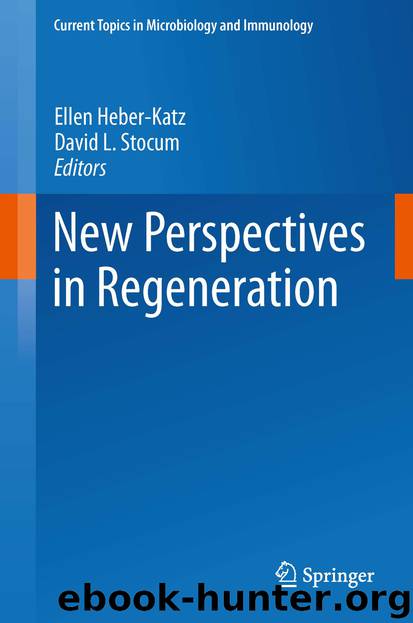New Perspectives in Regeneration by Ellen Heber-Katz & David L. Stocum

Author:Ellen Heber-Katz & David L. Stocum
Language: eng
Format: epub
Publisher: Springer Berlin Heidelberg, Berlin, Heidelberg
2.4 When Nature Is not Enough: Tissue Engineering Approaches to Skeletal Muscle Repair
While the intrinsic muscle repair system has a robust capacity to repair muscle damage, there are limits to what it can accomplish. Satellite cell-based repair works extremely well for small, common injuries such as strains, tears, or lacerations. Severe traumatic injuries resulting in significant muscle tissue loss and gaps in muscle tissue are another matter. Such injuries are termed volumetric muscle loss (VML) injuries (Grogan and Hsu 2011). The endogenous muscle repair process is of little help in VML, as not only are muscle fibers and their supporting matrix lost, but satellite cells and myogenic cells of the interstitium are obliterated as well. Treatment options for VML are currently limited to limb bracing, free muscle transfers, and amputation. However, advances in materials science and stem cell technology, along with our increasing understanding of the endogenous muscle repair process, are now making tissue engineering approaches to treating VML more feasible.
Tissue engineering is a multidisciplinary field that applies the principles of life sciences and engineering to the development of implantable materials that can restore lost tissues or organs, or maintain and improve structure and function of degenerating tissues and organs (Langer and Vacanti 1993). Typical tissue engineering approaches utilize biocompatible scaffolds seeded with stem cells, growth factors, or combinations of both, which are implanted into a target to carry out repair or reformation of lost tissue. Scaffolds are three-dimensional (3D) constructs engineered to support tissue formation. They are usually designed to support cell attachment and migration, retain or deliver growth factors or other bioactive compounds, and display mechanical properties to support tissue formation and function. Scaffolds can be fabricated from biocompatible synthetic materials, or they can be produced using purified matrix proteins or complex multicomponent ECM preparations. ECM preparations have become an area of intense focus in tissue engineering (Badylak 2007; Lu et al. 2011). Numerous factors must be taken into account when designing a scaffold, but two parameters are particularly important: The first is pore size and extent of porosity of the scaffold, as this will affect the diffusion of nutrients and migration of cells throughout the scaffold, and influence the formation of a vascular network within the scaffold and the integration with vasculature of surrounding tissue (Novosel et al. 2011). Second, biodegradability is also a key, as the ideal scaffold should gradually break down and be resorbed while tissue is forming, eliminating the necessity for surgical removal of the scaffold material after completion of its function. Once designed and fabricated, scaffolds can be seeded with stem cells and growth factors and allowed to begin tissue formation in vitro before eventual implantation, or they can be implanted immediately after seeding.
Progress in engineering of skeletal muscle tissue has lagged compared to other tissues such as bone. This is due primarily to the complexity of skeletal muscle tissue. Skeletal muscle is a highly organized tissue, with bundles of muscle fibers running in parallel, surrounded by layers of connective tissue and penetrated
Download
This site does not store any files on its server. We only index and link to content provided by other sites. Please contact the content providers to delete copyright contents if any and email us, we'll remove relevant links or contents immediately.
| Administration & Medicine Economics | Allied Health Professions |
| Basic Sciences | Dentistry |
| History | Medical Informatics |
| Medicine | Nursing |
| Pharmacology | Psychology |
| Research | Veterinary Medicine |
Tuesdays with Morrie by Mitch Albom(4690)
Yoga Anatomy by Kaminoff Leslie(4306)
Science and Development of Muscle Hypertrophy by Brad Schoenfeld(4089)
Bodyweight Strength Training: 12 Weeks to Build Muscle and Burn Fat by Jay Cardiello(3915)
Introduction to Kinesiology by Shirl J. Hoffman(3725)
How Music Works by David Byrne(3187)
Sapiens and Homo Deus by Yuval Noah Harari(2987)
The Plant Paradox by Dr. Steven R. Gundry M.D(2547)
Churchill by Paul Johnson(2506)
Insomniac City by Bill Hayes(2498)
Coroner's Journal by Louis Cataldie(2432)
Hashimoto's Protocol by Izabella Wentz PharmD(2331)
The Chimp Paradox by Peters Dr Steve(2297)
The Universe Inside You by Brian Clegg(2097)
Don't Look Behind You by Lois Duncan(2080)
The Immune System Recovery Plan by Susan Blum(2027)
The Hot Zone by Richard Preston(1983)
Endure by Alex Hutchinson(1964)
Woman: An Intimate Geography by Natalie Angier(1882)
